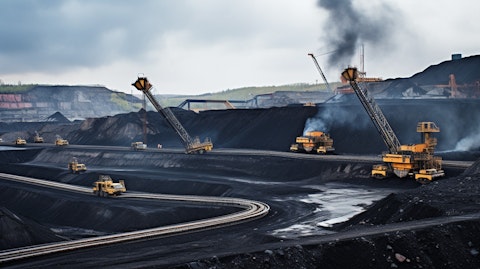Alpha Metallurgical Resources, Inc. (NYSE:AMR) Q1 2025 Earnings Call Transcript May 9, 2025
Alpha Metallurgical Resources, Inc. misses on earnings expectations. Reported EPS is $-2.496 EPS, expectations were $-1.53.
Operator: Greetings, and welcome to the Alpha Metallurgical Resources First Quarter 2025 Results Conference Call. At this time, all participants are in a listen-only mode. A question-and-answer session will follow the formal presentation. Please note this conference is being recorded. I will now turn the conference over to your host, Emily O’Quinn, Senior Vice President, Investor Relations and Communications. You may now begin.
Emily O’Quinn: Thank you, Rob, and good morning, everyone. Before we get started, let me remind you that during our prepared remarks, our comments regarding anticipated business and financial performance contain forward-looking statements and actual results may differ materially from those discussed. For more information regarding forward-looking statements and some of the factors that can affect them, please refer to the company’s first quarter 2025 earnings release and the associated SEC filing. Please also see those documents for information about our use of non-GAAP measures and their reconciliation to GAAP measures. Participating on the call today are Alpha’s Chief Executive Officer, Andy Eidson; and our President and Chief Operating Officer, Jason Whitehead. Also participating on the call are Todd Munsey, our Chief Financial Officer; and Dan Horn, our Chief Commercial Officer. With that, I will turn the call over to Andy.
Andy Eidson: Thanks, Emily, and good morning, everyone. Today, we announced financial results for the first quarter 2025. These include adjusted EBITDA of $5.7 million and 3.8 million tons shipped in the quarter. As we announced on our last earnings call, the extreme weather of January and February negatively impacted our first quarter results. Most notably, in cost of coal sales and tons shipped. As a reminder, the severe weather caused a confluence of events, which included lost shifts from absenteeism, power outages, snow and flooding impacts, as well as transportation delays, at and around our operations, but also along the way to DTA, which experienced its own share of inclement weather. Additionally, we had a few mines that dealt with geologic challenges independent of the weather, but once those issues subsided, we posted improved cost of coal sales numbers both in March and April.
Metallurgical coal indexes remained depressed in the first quarter, and these poor pricing conditions continued to weigh on our realizations. From a global macro perspective, weak steel demand persists, now with increased levels of uncertainty around the impact of tariffs and shifting trade policies. Barring a significant event or boost to global economic activity, we expect the coming months to remain challenging and we maintain a cautious outlook for the rest of the year. As we have communicated for several quarters, our focus continues to be on liquidity and safeguarding the company’s ability to financially weather these market conditions. To that end, we’ve taken some difficult actions, including cutting additional production at higher cost operations and reducing wages across the enterprise.
These kinds of decisions are never taken lightly, as we recognize the negative impact they can have on our workforce and our families. However, we believe these are necessary responses to the difficult circumstances of the current marketplace. Looking at the balance of 2025, we’ve announced further adjustments to sales volume guidance, considering the reduced production profile we anticipate for the year. At the midpoint of our adjusted guidance, we now expect to shift 15.3 million tons of coal this year, down 1.4 million tons from our initial midpoint of 16.7 million tons announced in November of 2024. We’ve also reduced our CapEx guidance by $27 million at the midpoint, bringing the range down to $130 million to $150 million. We believe these adjustments are possible without compromising safety anywhere in the organization.
We’re also confident that our Kingston Wildcat project can continue on schedule, even with a downward revision to our planned development CapEx for the year. In keeping with our focus on liquidity, Todd and his team have successfully secured an amendment to our asset-based lending facility, which closed earlier this week. This is a positive development and another example of actions we’re taking to protect the business. For more information on the amended and extended ABL and our Q1 financial results, I’ll turn the call over to Todd.
Todd Munsey: Thanks, Andy. We are pleased to announce the increase of the size of our ABL facility from its prior level of $155 million to $225 million. The company may also request an increase to the capacity of the facility of up to an additional $75 million, provided that $25 million shall be solely for cash collateralized letters of credit. Along with the ABL’s increase in size, we have extended its maturity to May of 2029. Detailed terms of the agreement may be found in this morning’s press release and SEC filings. The amended facility provides Alpha access to additional liquidity, and we value the optionality that this facility provides. Turning now to our financial results for the quarter, adjusted EBITDA for the first quarter was $5.7 million, down from $53 million in the fourth quarter of 2024.
We sold 3.8 million tons in Q1, down from the 4.1 million tons sold in Q4. Met segment realizations decreased quarter-over-quarter with an average realization of $118.61 in Q1, down from $127.84 for the fourth quarter. Export met tons priced against Atlantic Indices and other pricing mechanisms in the first quarter realized $119.39 per ton, while export coal priced on Australian indices realized $107.44. These results are compared to realizations of $122.24 per ton and $124.71, respectively, in the fourth quarter. The realization for our metallurgical sales in Q1 was a total weighted average of $122.08 per ton, down from $132.63 per ton in Q4. Realizations in the incidental thermal portion of the Met segment increased to $79.39 per ton in Q1, as compared to $75.39 per ton in the fourth quarter.
Cost of coal sales for our Met segment increased to $110.34 per ton in the first quarter, up from $108.82 per ton in Q4. This increase in costs was primarily driven by the previously disclosed weather-related issues. SG&A, excluding non-cash stock compensation and non-recurring items, decreased to $12.6 million in the first quarter as compared to $14.3 million in the fourth quarter. CapEx for the quarter was $38.5 million, down from $42.7 million in Q4. Moving to the balance sheet and cash flows, as of March 31, 2025, we had $448 million in unrestricted cash compared to $481.6 million of unrestricted cash as of December 31, 2024. We had $112.9 million in unused availability under our ABL at the end of the first quarter, partially offset by a minimum required liquidity of $75 million.
As of the end of March, Alpha had total liquidity of $485.8 million, down from $519.4 million at the end of December. Cash provided by operating activities was $22.2 million in the first quarter, down from $56.3 million in Q4. As of March 31, our ABL facility had no borrowings and $42.1 million of letters of credit outstanding. Looking to guidance, we reduced our metallurgical coal shipment guidance for the year to a range of 13.8 million to 14.8 million tons, and our thermal coal sales volumes to a range of 800,000 to 1.2 million tons. These adjustments bring our total shipment expectations for the year down to a range of 14.6 million to 16 million tons. We also lowered CapEx guidance to a new range of $130 million to $150 million for 2025, which equates to a reduction of $27 million at the midpoint from our prior range.

The $27 million is comprised of approximately $8 million in development CapEx and $19 million in maintenance capital. In terms of our committed position for 2025, at the midpoint of guidance, 50% of our metallurgical tonnage in the Met segment is committed and priced at an average price of $133.04. Another 45% of our Met tonnage for the year is committed, but not yet priced. The thermal byproduct portion of the Met segment is fully committed and priced at the midpoint of guidance at an average price of $80.75. Due to the continued softness in the Met coal markets, we did not repurchase any shares in the first quarter under the company’s share buyback program. I will now turn the call over to Jason to provide an update on operations.
Jason Whitehead: Thanks, Todd. Good morning, everyone. Looking at the first quarter results, our operations experienced significant challenges related to severe weather that caused our costs to go up. Further contributing to the atypical high costs in the quarter were some geologic challenges on three of our active underground mining sections. All three sections were required to mine through undesirable areas in order to develop access into better reserves. Once we got past the weather-related issues, I’m pleased to report that we did post better costs in March and expect those improvements to remain through the second quarter. We also expect that the momentum to continue as the impact of additional actions we’ve taken to reduce costs begin to flow through the business.
While difficult decisions to make, we recently idled roughly 500,000 tons of production on an annualized basis between the closure of our Long Branch Surface Mine in Virginia and the idling of a section or approximately a third of our productive capacity at our Jerry Fork Mine in West Virginia. These two operations were among Alpha’s higher cost mines, which factored into our decision making. In both instances, we looked for opportunities to match impacted miners with other job opportunities in the company. These efforts reduced the overall number of layoffs and helped fill human resources needs in other parts of the company. Additionally, at the end of March, we announced market-driven pay reductions across the organization to better align our compensation rates with the vastly weakened market conditions.
As we’ve said on several calls in the past, the labor market coming out of COVID was extremely tight and demanded significant incremental investment to attract and retain our skilled workforce. Now that market conditions have changed so significantly, these wage adjustments, which just went into effect a couple weeks ago, better match our business to the market reality. Turning to the work happening on Kingston Wildcat, we continue to see progress across many aspects of the mine development project. Wildcat is our new low vol mine in Pax, West Virginia. The slope [ph] development now is approximately 75% complete, with our crews having pushed to a depth of over 1,300 feet. Construction is underway on the sporting structures, like the roll coal load out at Pax and the offloader facility at our Mammoth Preparation Plant.
Importantly, we believe we can continue the project safely and on our existing timeline while trimming roughly $8 billion from the development CapEx budget for this year. We remain optimistic about the ability to begin taking development cuts in coal at the end of 2025 and ramping up in 2026 to a full run rate which we expect to be approximately 1 million tons per year. With those operational updates, I’ll now turn the call over to Dan for some detail on the market.
Dan Horn: Thanks, Jason and good morning, everyone. Metallurgical coal markets remained under pressure during the first few months of 2025, with pricing levels deteriorating during Q1 because of depressed steel demand across the globe. Increased economic uncertainty, exacerbated by significant shifts in trade policy in recent weeks, is expected to produce continued volatility. During the first quarter of 2025, all four indices that Alpha closely monitors fell 8% or more throughout the quarter, with the Australian Premium Low Vol Index representing the most significant drop of 15.5%. The Australian Premium Low Vol index decreased from $199.90 per metric ton at the beginning of January to $169 per metric ton at the end of March.
The U.S. East Coast Low Vol Index fell from $190 per metric ton in January to $174 per metric ton in March. The U.S. East Coast High Vol A index decreased from $185 per metric ton at the beginning of the quarter to $168 per metric ton at quarter close. And finally, the East Coast High Vol B Index moved from $153 per metric ton to $157 per metric ton at quarter end. In recent weeks, all four indices have increased from their quarter end levels. As of May 8, 2025, the Australian Premium Low Vol Index increased from quarter close levels to $190.50 per metric ton. The U.S. East Coast Low Vol, high volatile A, and high volatile B indices measured $181, $172.50, and $159 per ton, respectively, as of the same date. In the seaborne market, the — seaborne thermal market, the API 2 index was $111.30 per metric ton at the beginning of January and decreased to $104.25 per metric ton on March 31, 2025.
Since then, the API index — the API 2 index has dropped to $98.80 per metric ton as of May 8. While the indices have been moving slightly higher in recent weeks, isolated circumstances are most likely influencing these movements higher. The broad macroeconomic factors that underpin metallurgical markets, like steel demand and economic growth, continue to show weakness. The uncertainty created by the threat of trade wars has also weighed on growth projections for the near-term. In their World Economic Outlook published on April 22, 2025, the International Monetary Fund projected a slowdown in economic growth across the world because of newly announced U.S. tariffs that, if sustained, will be the highest in a century and likely result in a considerably higher global rate if counter-tariffs are imposed.
The IMF also noted the likelihood of inflation rising in connection with the higher tariff rates. The authors of the report acknowledged the complexities and unpredictability of potentially worsening trade tensions, tightened financial conditions, and the effect of tariffs on exchange rates. Importantly, the IMF noted that easing trade policy stances or new trade agreements could immediately and positively influence global growth prospects. An example of this rapidly shifting environment lies in the proposed action put forward by the United States Trade Representative in its Section 301 investigation of China’s targeting of the maritime, logistics, and shipbuilding sectors for dominance. Like many other companies and trade organizations, Alpha submitted a letter during the public comment period expressing concern about the proposed vessel fees and their potential negative impacts on our business.
Following hearings and the comment period, the Office of the U.S. Trade Representative provided revised guidance on the vessel fee structure and timeline. We are grateful that the most recent guidance details are, in our opinion, much improved and include exemptions for empty vessels coming into American ports. If the projected action moves forward based on the revised proposal, we no longer believe Alpha will experience any related material adverse impacts. We continue to watch the shifting tariff and trade landscape for any other potential impacts to Alpha. Lastly, the team at DTA is currently working through the 2-week outage we mentioned on our last call. As a reminder, this outage is part of the multi-year program to upgrade equipment and infrastructure at the facility.
We worked with DTA leadership in advance to plan for this period of downtime and minimize disruption to our shipping operations. However, it’s reasonable to expect some shipments could be delayed as a result. We expect full utilization of the facility to resume by May 18. And with that, operator, we are now ready to open the call for questions.
Q&A Session
Follow Alta Mesa Resources Inc. (NYSE:AMR)
Follow Alta Mesa Resources Inc. (NYSE:AMR)
Receive real-time insider trading and news alerts
Operator: Thank you. [Operator Instructions] Our first question comes from Nick Giles with B. Riley Securities. Please proceed with your question.
Nick Giles: Thank you, operator. Good morning, everyone. Per Jason’s comments, it sounds like there have been some more recent cost-cutting measures, and you’ve maintained your cost guidance. So I imagine that these measures have mostly offset the loss of fixed-cost absorption, but curious if you had any additional thoughts and how we should really think about cadence of costs from here. Thank you very much.
Andy Eidson: Hey, Nick. Yes, that was an important thing to us as you picked up on. We’ve now taken well over a million tons out of our original guidance from last November as far as production and sales and while we did blip up our cost guidance a little bit back in February, being able to take that many tons out while continuing to hold guidance relatively firm is a pretty good accomplishment. The team has worked really hard to do that. I do think as we continue through the year, we’ll maintain more pressure. Obviously, all options remain on the table and there could be some other opportunities where some mines maybe aren’t performing the way we need them to in this market. But I think at this point, we feel like we’re in pretty good shape with the portfolio.
And also I think the team’s done a really nice job of focusing on the areas to improve that can be improved. There are always more opportunities. Jason likes to refer to the land of opportunity. We’ve always got more room to make improvements, and we stay pretty acutely focused on that.
Nick Giles: Andy, that’s very helpful. I appreciate that. Just on really the volumes and the CapEx, should we think about your $35 million CapEx cut at the midpoint? Should we think about this as primarily growth-related? And so what would you ultimately need to see to bring some of these growth projects back into production? And maybe just in response to your comments just then, I mean is there a way to quantify potential downside we could see to guidance from here if the market remains unchanged. Thank you.
Jason Whitehead: Hi. This is Jason, and I’ll take the first part of that at least, but I think most of the capital reductions are related to the closures that we announced earlier today, and it’s really about just re-racking and re-deploying the assets from those closures to offset items that were budgeted for other operations in the company. Additionally, there’s a little bit of growth CapEx that we’ve decided to take on in-house and take margins away from third-party providers, and we see some real opportunity there to reduce spend. So, really, I don’t see any impact on the future of the business by any of these changes.
Andy Eidson: Yes, and Nick, just to reiterate, we’re still full steam ahead on the Kingston Wildcat project. In our view, this is one of the more important projects we’ve had in a long time, considering it’s a premium low vol product, just over a million tons per year expected when it’s at its full run rate. So we’re continuing that project, as Jason mentioned. The team found some opportunities to bring some of that capital in-house, do some of the work with our own team and reduce the installation costs, but the project is still 100% moving forward.
Nick Giles: That’s good to hear. Thanks for that, both Jason and Andy. Let me just one more, if I could, on the realization side. Realizations, obviously, remain under pressure. So, Dan, I was wondering if you could just speak to mixing the quarters ahead and kind of what you’re seeing out there, per end market, whether it be from a CFR basis, some of the transportation differentials, any considerations as we model future quarters?
Dan Horn: Yes, Nick, well, we don’t — at Alpha, we do very little CFR business. The majority of it is all FOB vessel. So there’s certainly the freight market has been kind of exciting for a while. It’s calmed down. Just with the global slowdown, ocean freight generally is — rates are not very high compared to historical. So the challenge in the coming quarters is simply the steel business. You tell us how — tell us how good the steel business will be, we’ll tell you how much the prices move up because we believe they will as demand increases but we’re simply not seeing the growth in steel demand that we thought we’d see.
Nick Giles: Thanks for that, Dan. Guys, continue best of luck. Thank you.
Andy Eidson: Thanks, Nick.
Operator: Our next question comes from Nathan Martin with The Benchmark Company. Please proceed with your question.
Nathan Martin: Thanks, operator. Good morning, everyone. Full year shipment guidance trim is 700,000 tons at the midpoint. Is that all export? Is there any domestic in there? Maybe how many tons do you guys expect to ship domestic versus export in ’25 at this point? And then with the two operations coming offline, Jason, I think you said as well, Long Branch and Terry Fork, does that impact really your quality mix at all? It sounds like cost per ton, they are a little bit higher cost, but you guys still feel confidence with guidance?
Dan Horn: Yes, Nate, this is Dan. Hey, on — those tons that came offline would be export tons. The Jerry Fork Mine does ship some domestic business, but we’ll continue to be able to ship those orders. So, think of that reduction as coming off of the seaborne market. I’ll take part of the question you aimed at Jason there, too. The coal that came off is all high vol. Some of it’s rather high-quality, but it’s all high vol. There’s no medium vol or low vol in that number.
Nathan Martin: Thanks, Dan. Appreciate that. And then maybe going back to the last question that Nick asked as far as your average realized price per ton for you guys and really most of your peers probably a little bit lower than most had expected here in the first quarter. Do you guys believe there’s some discounting maybe going on to publish indices at this point to move coal? Just would appreciate any thoughts you have there, Dan?
Dan Horn: Well, yes, I think I’ve said this before on these calls Nate. In a weak market, tends to be more discounting against the indices. In a strong market, you tend to see flat or even premiums and we are obviously in a weaker market. So short answer is yes, there’s some discount against the indices, but not in every case. I can tell you we recently concluded a piece of business where we got a premium to the index. So, it’s not universal that every ton is sold at a discount.
Nathan Martin: Okay, great. Nice to hear. And then maybe just one more bigger picture. I think, Andy, last quarter you talked about keeping your eyes open for any potential opportunities to fortify your operations. Any updates there, what you’re seeing in the marketplace?
Andy Eidson: No. And it’s pretty obviously there’s — there are a lot of opportunities out there, lot of distressed companies and things being shot. At this point, we kind of go through the filter of what’s available. We have to find something that accretion is the challenge here. We don’t want to be approaching assets that could put an additional strain on the enterprise while we don’t have great visibility on when this thing turns around. So it’s a little bit challenging to pursue M&A right now. Also we’ve got to find something that truly makes Alpha better. And so for that reason we remain focused on the internal opportunities particularly the Kingston and Wildcat mine as our main focus for now because it most definitely will make the portfolio stronger in the very near-term. So right now it’s kind of still a wait and see. We’re always open to options but we’ve not seen anything that we are ready to act upon just yet.
Nathan Martin: Yes. I think that’s probably the prudent thing. Makes sense. I appreciate that Andy. I will leave it there guys and best of luck going forward.
Andy Eidson: Thanks Nate. Appreciate you.
Operator: We have an additional question from Nick Giles with B. Riley Securities. Please proceed with your question.
Nick Giles: Thanks so much for taking my follow-up. I know it’s early here, but as we start to think later in the year around domestic contracting, your domestic book is providing some insulation in this weak market. So would there be any consideration to increase those volumes? Are you thinking about the domestic opportunity as we head into the summer?
Dan Horn: Thanks, Nick. It is, as you said, it’s a little early. We will be looking at our portfolio, what the customers’ needs are. Broadly speaking, we don’t ever have a number in mind when we approach the domestic market. We take it as it comes. We meet with the customers, see where there we have common ground and where we don’t. So I really don’t have a firm answer for you there. Certainly, at this point in time, the domestic market is among the higher pricing in our book, but that can change within a matter of months. So it’s something we will be looking at over the summer months here at Alpha.
Nick Giles: Thanks for that Dan. And maybe if I could just sneak in one more. Just back to the market, the U. S. market specifically and there’s been for several months now word of a lot of your smaller competitors that might be struggling. There’s been some — there’s been plenty of evidence of that. Do you think are there still some kind of small mom and pop tons that could come out of the market? Or do you think most of the pain has been inflicted at this point?
Dan Horn: Yes. I think we still think there are some tons that could come out.
Andy Eidson: Yes. The question at this point, Nick, is and it’s been a grind since, I guess, probably Thanksgiving of last year. The amount of liquidity being consumed off of balance sheets across the industry and how much longer some of the less well capitalized companies can last. So I think Dan’s dead on. There are likely more tons that have exposure in this particular market. So we will just — we will have to see how that develops.
Nick Giles: Got it. And apologies, I promise this will be my last question. But you are very well capitalized. And so that offers some protection in these tough markets. Has this market and its prolonged nature changed the way you’re thinking about your cash balance through the cycle?
Andy Eidson: Well, that’s a good question. I mean, it’s something that we constantly evaluate and it’s the answer will always be different depending on where you are in the cycle. And we had a really good, call it 2.5 year run where everyone kind of gravitated toward the same answers on how they wanted to treat their balance sheet. I think we’ve been — I think we were prescient in our approach about this time last year and how we decided to handle our balance sheet. We will probably — I’m not sure we would do anything different moving forward. So it’s a tough question to answer, but it’s one that we ask ourselves every day.
Nick Giles: Fair enough. And Andy and team, I think your foresight was as good as any. So continue best of luck and thanks for taking all my questions.
Andy Eidson: Thank you, Nick. Appreciate you.
Operator: We have reached the end of the question-and-answer session. I will now turn the call over to Andy Eidson for closing remarks.
Andy Eidson: Well, thanks again to everyone for joining the call this morning. We appreciate your interest in Alpha and we all hope you all have a great weekend. Take care.
Operator: This concludes today’s conference. You may disconnect your lines at this time and we thank you for your participation.
Follow Alta Mesa Resources Inc. (NYSE:AMR)
Follow Alta Mesa Resources Inc. (NYSE:AMR)
Receive real-time insider trading and news alerts




